The rapid development of new technologies means that IT systems need near-constant updates and modifications so that working with them can be more efficient, but also more convenient. This dynamic progress means that the requirements of customers are not limited to product quality. Efficiency of service and speed of response to market changes are also very important. Moreso, properly designed and executed IT systems organize the flow of information and improve the efficiency of communication inside and outside the company.
Designing and implementing dedicated IT solutions for business is one of our main activities at OnlineIdea. We co-create easy-to-use web and mobile applications that support business growth. We tailor digital products to individual needs in such a way that they perceptibly and efficiently streamline work and effectively support users in various processes, related to for example: reporting, sales, marketing, maintenance and many more.
What is the procedure for implementing dedicated applications at OnlineIdea?
Implementation of an IT system is a multi-stage process aimed at providing the recipient with software tailored to their specific needs. The process includes both activities preceding the product launch and the ones after it such as maintenance, further development and technical support.
We implement our solutions according to a seven-step scheme.
1. Pre-implementation analysis and discussion with the customer about the application
- Goal setting. The first consultation is about the basic assumptions of the project. We talk about what is the purpose of creating a digital product, how it should work and who is the target audience.
- Setting limitations. We determine the technical requirements to enable the system to operate smoothly, as well as the estimated number of users. We design the initial software architecture based on these specific parameters.
- Setting the budget. During discussions with the client, we determine the final scope of the project. We discuss the underlying assumptions and create a functional description of the application. This allows us to determine the time needed for the implementation and the associated costs.
2. Preparation of the implementation plan
If the first step produced mixed results, we usually conduct a full workshop to better understand the client's expectations and thoroughly analyze the product vision (you can read more about this in the article: Product workshops - what do they look like and why are they crucial in IT projects?).
3. Application implementation process
At this stage, we begin the actual implementation activities and draw up a work schedule, including the precise time frame. We prepare the graphics layer of the system based on UX mockups, outline the functionalities and divide the responsibilities in the team. We implement the various stages and check internally, step by step, the finished functionalities.
4. Conducting tests of the delivered product together with the client
During the verification phase, the client is given access to the application in the test environment and tools through which they can come back to us with feedback. The development team implements the changes, and they go through another round of testing. The revision process continues for a contractually defined period of time, until all functionalities are accepted by the client.
5. Creation of post-implementation documentation
At this stage, we collect all the documentation developed so far in a single document and hand it over to the Client. We create precise guidelines for administrators and users of the system.
6. Explaining the operation
Near the end of the project, we conduct an implementation training in remote or onsite form, thanks to which, the users can smoothly start using the application. We familiarize employees with the product and the capabilities of the specific modules. At the same time, we explain all of the technical issues to the administrators and present the advanced operating features.
7. Proper launch of the system
Finally, we deploy the final version of the system in the production environment and hand over access to the client. After the final launch, we continuously monitor its functioning, make necessary updates and adjustments to make it secure, efficient and employee-friendly.
Technical assistance for deployed applications
When implemented we offer comprehensive technical support for the system and maintenance services are directed at ensuring its reliability and performance. We watch over the continuity of work and provide assistance to the end users. If the need arises, we implement minor improvements and consult on new functionalities that are to be implemented in the future.
Implementing an IT system is a multi-step process that requires proper preparation and planning. At OnlineIdea, we know how important it is to quickly detect potential problems and solve them at the very beginning. We use tools, such as product workshops, which allow us to comprehensively analyze the client's vision in order to minimize all known risks. Try us out!





